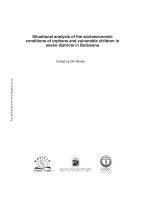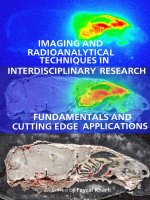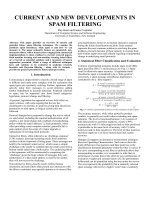image analysis, sediments and paleoenvironments developments in paleoenvironmental research
Bạn đang xem bản rút gọn của tài liệu. Xem và tải ngay bản đầy đủ của tài liệu tại đây (11.35 MB, 349 trang )
Image Analysis, Sediments and Paleoenvironments
Developments in Paleoenvironmental Research
VOLUME 7
Image Analysis, Sediments and
Paleoenvironments
Edited by
Pierre Francus
Springer
eBook ISBN: 1-4020-2122-4
Print ISBN: 1-4020-2061-9
©2005 Springer Science + Business Media, Inc.
Print ©2004 Springer
All rights reserved
No part of this eBook may be reproduced or transmitted in any form or by any means, electronic,
mechanical, recording, or otherwise, without written consent from the Publisher
Created in the United States of America
Visit Springer's eBookstore at:
and the Springer Global Website Online at:
Dordrecht
DEDICATION
I dedicate this book to my wife, Sophie Magos
This page intentionally left blank
Table of Contents
Editors and Board of Advisors of Developments in Paleoenvironmental
List of Contributors
1. An introduction to image analysis, sediments and paleoenvironments
Pierre Francus, Raymond S. Bradley and Jürgen W. Thurow 1
Part I: Getting started with Imaging Techniques
(or methodological introduction)
2. Image acquisition
Scott F. Lamoureux and Jörg Bollmann 11
Introduction
Image acquisition and paleoenvironmental research
Sample preparation for image acquisition
Acquisition methods
Summary
Acknowledgments
References
3. Image calibration, filtering and processing
Alexandra J. Nederbragt, Pierre Francus, Jörg Bollmann
and Michael J. Soreghan 35
Introduction
Image pre-processing
Colour information and calibration
Image processing
Metadata
Summary
Acknowledgments
Appendix
References
TheEditor xii
.
Aims & Scope of Developments in Paleoenvironmental Research Book Series ix
ii
xv
Research Book Series xiv
4. Image measurements
Eric Pirard 59
Introduction
Digital imaging and sampling theory
Dealing with the available information
Digital image analysis strategies
Intensity and color analysis
Blob analysis
Structural analysis
Summary
Acknowledgments
References
5. Testing for sources of errors in quantitative image analysis
Pierre Francus and Eric Pirard 87
Introduction
Some useful definitions
Preparation errors
Integration errors (sampling)
Analysis errors
Future directions
Summary
Acknowledgments
References
Part II: Application of Imaging Techniques
on Macro- and Microscopic Samples
6. Digital sediment colour analysis as a method to obtain high
resolution climate proxy records
Alexandra J. Nederbragt and Jürgen W. Thurow 105
Introduction
Image data collection
Extracting colour data
Light correction
RGB to L
∗
a
∗
b
∗
conversion and colour calibration
Mosaicking
Examples and comparison with other methods
Summary
Acknowledgments
References
viii
7. Toward a non-linear grayscale calibration method for legacy
photographic collections
Joseph D. Ortiz and Suzanne O’Connell 125
Introduction
What is grayscale analysis?
Evaluating the nonlinear correction method
Summary
Acknowledgments
Metadata
References
8. From depth scale to time scale: transforming sediment image color
data into a high-resolution time series
Andreas Prokoph and R. Timothy Patterson 143
Introduction
Wavelet analysis
Image processing
Methodology
Testing of the method
Example: Marine Laminated sediments from the west
coast of Vancouver Island, NE Pacific
Summary
Acknowledgments
References
9. X-ray radiographs of sediment cores: a guide to analyzing diamicton
Sarah M. Principato 165
Introduction
Image acquisition
Image processing
Image measurement
Advantages of using image analysis
Drawbacks to image analysis
Example: case study of five diamicton units
from North Atlantic continental margins
Future direction
Summary
Acknowledgments
Metadata
References
ix
10. Application of X-ray radiography and densitometry in varve analysis
Antti E. K. Ojala 187
Introduction
Methods
Examples from Lake Nautajärvi clastic-organic varves
Summary
Acknowledgments
References
11. Processing backscattered electron digital images of thin sections
Michael J. Soreghan and Pierre Francus 203
Introduction
Image acquisition
Image processing
Image measurement
Case study: grain size analysis of upper Paleozoic loessites
Discussion and recommendations for BSE image analysis
Future direction
Summary
Acknowledgments
Metadata
References
Part III: Advanced Techniques
12. Automated particle analysis: calcareous microfossils
Jörg Bollmann, Patrick S. Quinn, Miguel Vela, Bernhard Brabec,
Siegfried Brechner, Mara Y. Cortés, Heinz Hilbrecht, Daniela N. Schmidt,
229
Introduction
Automated image acquisition
Automated classification
What can be improved?
Summary
Acknowledgments
Appendix: system description
References
x
Ralf Schiebel and Hans R. Thierstein
13. Software aspects of automated recognition of particles:
the example of pollen
Ian France, A. W. G. Duller and G. A. T. Duller 253
Introduction
Acquisition of microscopic images
Feature extraction
Example: pollen classification using a neural network
Future directions
Summary
References
14. Multiresolution analysis of shell growth increments
Eric P. Verrecchia 273
Introduction
Spectral analysis
Wavelet Transform
Multiresolution analysis
Application to growth increment detection
Conclusion
Summary
Acknowledgments
References
Glossary, acronyms and abbreviations 295
Index 319
xi
to detect variations in natural cycles
THE EDITOR
Pierre Francus is a professor in the Centre Eau, Terre et Environnement at the
INRS (Institut national de la recherche scientifique), Québec,
xii
Québec city,
en G ochimie et en G odynamique
).
é
Canada. Pierre Francus is a member of the GEOTOP (Centre de recherche
é
AIMS AND SCOPE OF
DEVELOPMENTS IN PALEOENVIRONMENTAL RESEARCH
SERIES
Paleoenvironmental research continues to enjoy tremendous interest and
progress in the scientific community. The overall aims and scope of the
Developments in Paleoenvironmental Research book series is to capture this
excitement and document these developments. Volumes related to any aspect of
paleoenvironmental research, encompassing any time period, are within the
scope of the series. For example, relevant topics include studies focused on
terrestrial, peatland, lacustrine, riverine, estuarine, and marine systems, ice cores,
cave deposits, palynology, isotopes, geochemistry, sedimentology, paleontology,
etc. Methodological and taxonomic volumes relevant to paleoenvironmental
research are also encouraged. The series will include edited volumes on a
particular subject, geographic region, or time period, conference and workshop
proceedings, as well as monographs. Prospective authors and/or editors should
consult the series editors for more details. The series editors also welcome any
comments or suggestions for future volumes.
xiii
EDITORS AND BOARD OF ADVISORS OF
DEVELOPMENTS IN PALEOENVIRONMENTAL RESEARCH BOOK
SERIES
Series Editors:
John P. Smol
Paleoecological Environmental Assessment and Research Lab (PEARL)
Department of Biology
Queen’s University
Kingston, Ontario, K7L 3N6, Canada
e-mail:
William M. Last
Department of Geological Sciences
University of Manitoba
Winnipeg, Manitoba R3T 2N2, Canada
e-mail:
Advisory Board:
Professor Raymond S. Bradley
Department of Geosciences
University of Massachusetts
Amherst, MA 01003-5820 USA
e-mail:
Professor H. John B. Birks
Botanical Institute
University of Bergen
Allégaten 41
N-5007 Bergen
e-mail:
Dr. Keith Alverson
xiv
Director, GOOS Project Office
UNESCO
1, rue Miollis
75732 Paris Cedex 15
Norway
e-mail:
France
Tel: +33 (0)1-45-68-40-42
Fax: +33 (0)1-45-68-58-13 (or 12)
Intergovernmental Oceanographic Commission (IOC)
LIST OF CONTRIBUTORS
JÖRG BOLLMANN
Department of Earth Sciences
ETH and University Zurich
Sonneggstrasse 5, 8092 Zurich
Switzerland
e-mail:
BERNHARD BRABEC
Department of Earth Sciences
ETH and University Zurich
Sonneggstrasse 5, 8092 Zurich
Switzerland
RAYMOND S. BRADLEY
Climate System Research Center
Department of Geosciences,
University of Massachusetts
Amherst, MA 01003-9297, USA
e-mail:
SIEGFRIED BRECHNER
Department of Earth Sciences
ETH and University Zurich
Sonneggstrasse 5, 8092 Zurich
Switzerland
MARA Y. CORTÉS
Department of Earth Sciences
ETH and University Zurich
Sonneggstrasse 5, 8092 Zurich
Switzerland
A.W.G. DULLER
picoChip Designs Ltd.
Riverside Buildings
108 Walcot Street, Bath
BA1 5BG, United Kingdom
e-mail:
G.A.T. DULLER ()
Institute of Geography and Earth Sciences,
University of Wales,
Aberystwyth, Ceredigion,
SY23 3DB, Wales, UK
e-mail:
xv
PIERRE FRANCUS
Climate System Research Center,
Department of Geosciences,
University of Massachusetts,
Amherst, MA 01003-9297, USA
Currently at
INRS - Eau, Terre et Environnement
e-mail:
HEINZ HILBRECHT
Department of Earth Sciences
ETH and University Zurich
Sonneggstrasse 5, 8092 Zurich
Switzerland
SCOTT F. LAMOUREUX
Department of Geography
Queen’s University
Kingston, ON
K7L 3N6 Canada
e-mail:
ALEXANDRA J. NEDERBRAGT
Department of Geological Sciences,
University College London,
Gower Street,
London WC1E 6BT, UK
e-mail:
SUZANNE O’CONNELL
Department of Earth and Environmental Sciences
Wesleyan University
Middletown, CT 08457, USA
e-mail:
ANTTI E.K. OJALA
Geological Survey of Finland
P.O. Box 96
FIN-02150, Espoo
Finland
e-mail:
I. FRANCE
FCS
Caerau
Llansadwrn, Gwynedd
LL57 1UT, Wales, UK
e-mail:
xvi
é
490 rue de la Couronne, Qu bec (QC) G1K 9A9, Canada
ERIC PIRARD
Département GeomaC - Géoressources Minérales
Université de Liège
Sart Tilman B52/3
4000 Liège, Belgium
e-mail:
SARAH M. PRINCIPATO
Institute of Arctic and Alpine Research and Department of Geological Sciences
University of Colorado, Campus Box 450
Boulder, CO 80309-0450, USA
Currently at
Department of Environmental Studies, Box 2455,
300 N. Washington St
Gettysburg College
Gettysburg, PA 17325, USA
e-mail:
ANDREAS PROKOPH
SPEEDSTAT
36 Corley Private
Ottawa, Ontario
K1V 8T7, Canada
e-mail:
PATRICK S. QUINN
Department of Earth Sciences
ETH and University Zurich
Sonneggstrasse 5, 8092 Zurich
Switzerland
e-mail:
JOSEPH D. ORTIZ
Department of Geology
Kent State University
Lincoln and Summit Streets
Kent, OH 44224, USA
e-mail:
R. TIMOTHY PATTERSON
Department of Earth Sciences and Ottawa-Carleton Geoscience Centre,
Herzberg Building, Carleton University
Ottawa, Ontario
K1S 5B6, Canada
e-mail:
xvii
HANS R. THIERSTEIN
Department of Earth Sciences
ETH and University Zurich
Sonneggstrasse 5, 8092 Zurich
Switzerland
e-mail:
JÜRGEN W. THUROW
Department of Geological Sciences
University College London
Gower Street, London WC1E 6BT, UK
e-mail:
MIGUEL VELA
Department of Earth Sciences
ETH and University Zurich
Sonneggstrasse 5, 8092 Zurich
Switzerland
ERIC P. VERRECCHIA
Institut de Géologie
Universit de Neuchˆatel
Rue Emile Argand 11
2007 Neuchâtel, Switzerland
e-mail:
DANIELA N. SCHMIDT
Department of Earth Sciences
ETH and University Zurich
Sonneggstrasse 5, 8092 Zurich
Switzerland
e-mail:
MICHAEL J. SOREGHAN
School of Geology and Geophysics,
University of Oklahoma,
Norman, OK 73019, USA
RALF SCHIEBEL
Department of Earth Sciences
ETH and University Zurich
Sonneggstrasse 5, 8092 Zurich
Switzerland
e-mail:
xviii
100 E. Boyd St.
e-mail:
é
1. AN INTRODUCTION TO IMAGE ANALYSIS, SEDIMENTS
AND PALEOENVIRONMENTS
PIERRE FRANCUS ()
Climate System Research Center
Department of Geosciences
University of Massachusetts
Amherst, MA 01003-9297
USA
Currently at
INRS - Eau, Terre et Environnement
Canada
RAYMOND S. BRADLEY ()
Climate System Research Center
Department of Geosciences
University of Massachusetts
Amherst, MA 01003-9297
USA
JÜRGEN THUROW ()
Department of Geological Sciences
University College London
Gower Street, London WC1E 6BT
UK
Keywords: Visual information, Quantification, Geosciences, Image acquisition, Image processing, Image mea-
surement, Quality control, Neural networks, Recommendations
Image analysis is concerned with the extraction of quantitative information from images
captured in digital form (Fortey 1995). Visual information has always played an impor-
tant role in the Geosciences — indeed, many disciplines rely heavily on the content of
images, whether they are sketches drawn in the field, or descriptions of microscopic slides
(Jongmans et al. 2001). Visual charts are often used in sedimentology in order to provide
some semi-quantification, such asfor instance, Krumbein’s grain roundness classes(Krum-
bein 1941), classification of ichnofabric (Droser and Bottjer 1986), or simply the chart of
phase percentages sitting nearby every binocular microscope. However, with the noticeable
1
P. Francus (ed.) 2004. Image Analysis, Sediments and Paleoenvironments. Kluwer Academic
Publishers, Dordrecht, The Netherlands.
é
490 rue de la Couronne, Qu bec (QC) G1K 9A9
2 FRANCUS, BRADLEY AND THUROW
exception of remote sensing, compared to other disciplines image analysis has been slow
to develop in the Geosciences, despite its potential usefulness. One problem with image
analysis studies of geologic material is that objects are generally less homogenous than
biologic or medical samples, and observation conditions are more variable.
Digital imagingsystems were the exceptionin the80’s, because the computers needed to
process sizeable images were cutting edge and expensive systems, mostly entirely tailored
for that unique purpose. The decreasing price of personal computers, with their simultane-
ous and dramatic increase in performance, made digital image processing more accessible
to researchers in the 90’s. Soil scientists, especially micromorphologists, have been very
active inthe development ofnew image analysis tools (e.g., Terribile and Fitzpatrick (1992),
VandenBygaart and Protz (1999), Adderley et al. (2002)). The growing interest for image
analysis in Earth Sciences is revealed by the increasing number of initiatives to bring
image analysis into the spotlight. Without being exhaustive, one can mention a number
of meetings on the subject (e.g., Geological Society of London, London, UK, September
1993, and Geovision held in Liège, Belgium, in May 1999), an increasing number of papers
in journals such as Computers & Geosciences, and books (e.g., De Paor (1996)). In the
second volume of the Developments in Paleoenvironmental Research (DPER) series, a
chapter by Saarinen and Pettersen (2001) was already devoted to image analysis applied to
paleolimnology.
Paleoenvironmental studies of sediments can greatly benefit from image analysis tech-
niques. Because it is a low cost and high-resolution analysis method, image analysis allows
sediment cores to be studied at the very high resolution that is necessary to resolve high
frequency climate cycles. For instance, image analysis of varved sediments can contribute
to a better understanding of past climate variability, providing that chronologies are verified
and quantitative relationships are established between the sedimentary record and climate.
A wide range of data can be acquired using image analysis.Visual data include counting
of laminations (to build-up time scale), measurement of lamination thickness, and estab-
lishment of sediment properties (chemistry, mineralogy, density) from its color. Physical
data are for instance the morphometry of microfossils such as diatom and coccoliths, grain
size, grain morphometry, sediment fabric. Chemical and mineralogical data can be inferred
from images of tools such as XRF-Scanning, IR-Scanning, and energy and wavelength
dispersive spectrometry. Other tools used are X-radiography, core scanning, non-normal
scanning, optical and electron microscopy.
An international group of scientists, mainly marine and lacustrine sedimentologists,
gathered at the University of Massachusetts, Amherst, in November 2001 to review this
subject, and to make an update of the latest techniques available. The workshop entitled
Image Analysis: technical advances in extracting quantitative data for paleoclimate re-
construction from marine and lacustrine sequences was sponsored by the US-National
Science Foundation (NSF) and the International Marine Past Global Change Study (IM-
AGES) program. The participants of the workshop made recommendations (documented
in the appendix) promoting the use of low cost image analysis techniques and facilitating
intercomparisons of measurements in the paleoclimate community.
This volume is the natural extension — not the proceedings — of the workshop
because it addresses some of the concerns and fulfils some of the needs identified dur-
ing the workshop. Although image analysis techniques are simple, many colleagues
have been discouraged in using them because of the difficulty in gathering relevant
AN INTRODUCTION TO IMAGE ANALYSIS 3
information in order to set-up protocols and methodologies to solve a particular issue.
Often, specialized papers are only comprehensible by computer scientists, mathematicians
or engineers. Relevant information is scattered in the methods sections of many different
research papers, and is not detailed enough to be helpful for beginners. Also, monographs
on image analysis techniques (e.g., Russ (1999)) are oriented towards medicine, biology or
material science. Finally, specialized lectures remain very expensive. The DPER volume
7 intends to fill this gap, providing comprehensive but simple information on imaging
techniques for paleoenvironmental reconstruction in a single volume. By providing such
information, the user will understand every step involved in the imaging process, from
the acquisition to measurements, in order to be able to evaluate the validity of scientific
results obtained. This is necessary in order to allow image analysis techniques to mature
as widely accepted methodologies for paleoenvironmental reconstructions. In brief, this
volume intends to:
- provide a compendium of image analysis techniques available for paleoenvironmental
reconstruction retrieved mainly from lacustrine and marine sediment cores;
- cover image analysis techniques performed at the core-scale level (macroscopic,
sedimentary structure, color), and at the microscopic-scale (thin-section, and X-ray slabs);
- provide comprehensive descriptions of protocols, guidelines, and recommendations
for pertinent use of low cost image analysis techniques;
- review and illustrate the wide range of quantitative information that can be obtained
using image analysis techniques by showing case studies;
- show improvements that high-resolution studies using image analysis techniques can
bring about in paleoenvironmental reconstructions and in our understanding of environ-
mental changes.
In order to achieve these goals, the DPER volume 7 is divided into three parts. Part I is
designed more like a textbook by making a methodological and theoretical introduction,
that will allow the reader to become familiarized with the image analysis jargon, and to
figure out what are the different steps required to obtain reliable results. Image analysis
implies the following steps whatever the image application: image acquisition, calibration
and filtering (or pre-processing), image enhancement and classification (or processing),
image analysis (or image interpretation) (Jongmans et al. 2001). Part I tries to follow this
logical sequence. In Chapter 2, Lamoureux and Bollmann review the different technologies
(hardware) applicable for the study of lake and marine sediments, at a macroscopic and
microscopic scale in order to obtain the best possible digital images. Their contribution
points out issues that must be considered to account for artifacts in the acquisition process,
and prior to start the acquisition of an extensive set ofimages. Chapter 3by Nederbragt etal.
describes software-based operations used to perform the analysis of images (sensu lato),
i.e., image calibration, image filtering and image classification, as well as how to transform
popular RGB files within the CIE L*a*b* systems, more useful for paleoenvironmental
reconstructions. Pirard outlines in Chapter 4 the different kinds of measurements that can
be retrieved from images with a particular emphasis on the analysis of image intensities
(gray levels, colors) and individual objects (size, shape, orientation). Pirard also discuss
the problem of statistical representativity of the pixels and advocate for caution when
interpreting the results. In Chapter 5, Francus and Pirard illustrate how researchers can
test the validity of the results obtained using image analysis techniques, and advocate for
a systematic quality control of the results.
4 FRANCUS, BRADLEY AND THUROW
Part II of the volume illustrates six applications of imaging techniques performed
on macroscopic (images of surface of sediment cores) and microscopic (slabs and thin-
sections) samples using miscellaneous supports (digital and analog photography, X-ray,
electron microscopy) in order to reconstruct paleoenvironments. Chapter 6, by Nederbragt
and Thurow, outlines comprehensively how to extract color data from digital images of
sediment cores, focusing on techniques to filter out artifacts due to uneven illumination.
Ortiz and O’Connell explain in Chapter 7 how to retrieve quantified information from older
non-digital photographs, such as photographs of sediment cores from archived OPD and
DSDP cruises. In Chapter 8, Prokoph and Patterson describe an ingenious methodology
applicable to annually laminated sediments that transforms digital sediment color data
(recorded in a depth-scale) into a time-scale data set. Chapter 9, by Principato, describes a
simple methodology to quantitatively characterize diamictons from X-ray radiographs of
whole or half sediment cores. In Chapter 10, Ojala outlines how to acquire the best possible
X-radiographs of thin impregnated slabs of laminated sediments in order to perform the
counting and quantification of the laminae. Then, Chapter 11, by Soreghan and Francus,
reviews the issues during the acquisition of images using scanning electron microscopes
in backscattered mode, and illustrates the analysis of thin-sections of an old consolidated
loess deposit aiming for the reconstruction of paleowind intensity.
The last Part outlines advanced techniques that may prefigure what the future of image
analysis will be. Bollmann et al. describe in Chapter 12 robots that automatically acquire
images of microscopic samples (microfossils) aiming to process these images with auto-
mated recognitionsystems, i.e.,neural networks. The following Chapter 13, byFrance etal.,
focuses more onthe software aspect ofautomated recognitionby neural networks, providing
an example for automated recognition of pollen grains. Finally, Verrecchia examples the
uses of advanced mathematical tools, such as wavelet and multiresolution analysis in order
to analyze and retrieve measurements on images ofbanded/laminated samples.To complete
the book, a comprehensive glossary is included to help the reader to obtain a correct
understanding of the words used through this somewhat technical volume.
Computer scientists andengineers developnewpowerfultools andalgorithms everyday.
Geoscientists in general and sedimentologists in particular should take advantage of these
technological advances by looking for interdisciplinary collaborations. Some accomplish-
ments, suchas the automated recognition of microfossils, are not fulfilled yetbut are close to
completion.We need tobetter identify our needsin order toguide the next developments, and
this identification starts with a better understanding of what image analysis can accomplish.
The future of image analysis techniques in paleoenvironmental science will probably be
the integration of processing algorithms within the acquisition phase, allowing the scientist
to concentrate on the analysis of the data sets produced (Jongmans et al. 2001). The authors
hope that this volume will trigger new ideas for the use of imaging techniques. The topic
is new but the technique is very flexible, in such a way that “ imagination is the limit”
(Saarinen and Petterson 2001).
Acknowledgements
The authors thankthe Paleoclimate Program (GEO-ATM) ofUnited States NationalScience
Foundation and the International Marine Past Global Change Study (IMAGES) program
for funding of the workshop Image Analysis: technical advances in extracting quantitative
AN INTRODUCTION TO IMAGE ANALYSIS 5
data for paleoclimate reconstruction from marine and lacustrine sequences held at the
University of Massachusetts, Amherst, in November 2001. Pierre Francus is supported
by the University of Massachusetts, Amherst. We thank Frank Keimig (Climate System
Research Center) for his help during the edition of this volume.
Appendix: workshop recommendations
Proceeding with image analysis involves the same three major steps regardless of the type
of sample, e.g., surface of sediment core, thin-section, or the technique used to acquire an
image (RGB photography, X-radiography, scanning electron microscopy). These steps are
image acquisition, image processing and image measurement.
Image acquisition
It is emphasized that the quality of the image must be the best possible. A lot of energy
should be spent on this step. Acquiring images should involve:
Choice of the magnification, resolution, and size of image
One needs to consider the smallest feature that needs to be detected, the largest feature
that will be encountered and the representativity of the image with respect to the overall
sample.
Illumination
Variation of light intensity needs to be checked in the field of view, and the analyst must be
aware of spatial and temporal variations. To correct for irregular illumination, we recom-
mend acquisition of a photograph of the background (for example 18% gray sheet) at the
beginning of the image acquisition session and at the end.
Calibration standards
Where it is possible, spatial (ruler, grids) and color (gray/color chart, density wedges)
references should be acquired on each photograph. If not, the ruler and color/gray charts
should be acquired at the beginning and the end of each working session, keeping in mind
the needto maintainthe imageacquisition conditions strictly constantduring theacquisition
session. To maintain acquisition conditions strictly constant, it is also recommended that
images should beacquired in theshortest period oftime possible. Itwill avoid miscellaneous
problems due to aging of color charts or filament, moving equipment to another location,
changing hardware and software.
Metadata
It is criticalto record asmuch informationas possible regarding the factors thatcan influence
the quality of images. They include among other things, the characteristics and settings of
the acquisition device (e.g., depth of field, current intensity in a SEM filament) and any
event occurringduring theworking sessionsuch asa power failure.The calendarof working
session should also be noted.
6 FRANCUS, BRADLEY AND THUROW
Image processing
In order to insure the intercomparability of the measurements it is necessary to document
the software used and a detailed description of the filters used in the methods section or
metadata section of all published work. It is also recommended to avoid software that is
not explicit in explaining algorithms used for processing. For example, there are several
ways to compute a perimeter. The user needs to check what is the method used to do so, to
ensure comparability of different approaches.
A digital master or archive version of the image should be saved for each captured
image. File format involving lossy compression, such as Joint Photographic Experts Group
(JPEG), should be avoided by all means since compression involved loss of information
that can not be recovered. Uncompressed file formats, such as Tagged Image File Format
(TIFF), are recommended.
Image measurement
The representativity of the measurements made on digital images should always be kept
in mind because pixels are samples of an image, images are samples of the sample under
investigation, the samples under investigation are a sample of the sediment of interest.
Each step of the image analysis should be carefully tested using sets of calibration
images or test images. As a general principle, testing can be accomplished by slightly
varying a single component of image acquisition condition or processing procedure —
while maintaining the others strictly identical — and monitoring the impact on the final
measurements. It is impossible to review all the tests that need to be conducted here because
of the variety of procedures. However, the following steps should be carefully considered:
Related to image acquisition: magnification, resolution, contrast, brightness, color
coding systems (RGB, L*a*b*), hardware, image sampling representativity, illumination
(spatial repartition, drift), spatial deformation (parallax effect), pixel shape, 8-bit <> 16-bit
images, TIFF <> other formats imposed by hardware and software,
Related to image processing: noise removal filters, contrast/brightness manipulation,
image enhancement, segmentation and thresholding, edge detection, binary image manip-
ulation,
Related to image measurement: orientation, perimeters, distances, alignments, ellipse
fitting, and homemade indices.
WEB site
The workshop attendees recommended the compilation of a web site where the following
information can be gathered:
List of references related to image analysis.
List of hardware/software providers.
Documentation of computer codes or filters used in research paper.
A record and archive of metadata related to imaging techniques.
A place to publish things that do not work.
A place to publish testing of image analysis procedures.









